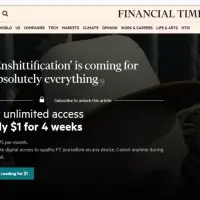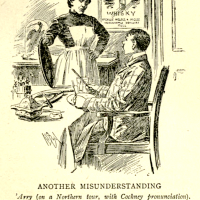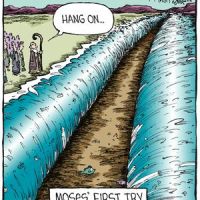 In the autumn of 1954 at the age of 56, C.S. Lewis was at the height of his academic career. With a chance to speak to the academic community at Cambridge and the listening world on the BBC, Lewis used this moment to reposition himself in an unusual way.
In the autumn of 1954 at the age of 56, C.S. Lewis was at the height of his academic career. With a chance to speak to the academic community at Cambridge and the listening world on the BBC, Lewis used this moment to reposition himself in an unusual way.
 Two years previously, in the first week of July, 1952, Lewis finished writing the decades-long project, English Literature in the Sixteenth Century, Excluding Drama. That same week, Lewis released Mere Christianity, a compendium of his WWII BBC talks on faith and life. Lewis continued to be recognized as a Christian public intellectual with bestselling books like The Screwtape Letters (1942). Mere Christianity, however, extended his reach, ultimately becoming a modern classic and one of the most influential works of popular Christian thought in the world.
Two years previously, in the first week of July, 1952, Lewis finished writing the decades-long project, English Literature in the Sixteenth Century, Excluding Drama. That same week, Lewis released Mere Christianity, a compendium of his WWII BBC talks on faith and life. Lewis continued to be recognized as a Christian public intellectual with bestselling books like The Screwtape Letters (1942). Mere Christianity, however, extended his reach, ultimately becoming a modern classic and one of the most influential works of popular Christian thought in the world.
And in the springtime of 1949, this bachelor Oxford don, literary critic, and Christian controversialist had a most suprrising manuscript in his hands: the first full draft of The Lion, the Witch and the Wardrobe. As influential as The Screwtape Letters and Mere Christianity would be for the intellectual and spiritual lives of Christians, so The Chronicles of Narnia have provoked curiosity and wonder and delight in millions of readers. Though the genre is new for Lewis, these Narnian stories are not a divergence from his other work of the perion. In the classic stories of Narnian adventure, Lewis was able to put in fairy-tale form all of his love of literature and his intimacy with Christian faith as the mythic core of human existence.
 On Sept 16th, 1954, after nearly two decades of research and writing what Lewis humorously called “OHEL”–a reference to the series title, “The Oxford History of English Literature”–English Literature in the Sixteenth Century, Excluding Drama was published. Lewis’ magnum opus intensified Lewis’ value as a literary historian by providing a unique look at the cultural spirit of the 16th century through hundreds of its poets and authors. Written with ever-present wit and remarkable brevity–a literary history so lively and provocative that I enjoy reading it, even though I haven’t read most of the original sources–Lewis was able to exceed the quality and usefulness of his groundbreaking The Allegory of Love (1936).
On Sept 16th, 1954, after nearly two decades of research and writing what Lewis humorously called “OHEL”–a reference to the series title, “The Oxford History of English Literature”–English Literature in the Sixteenth Century, Excluding Drama was published. Lewis’ magnum opus intensified Lewis’ value as a literary historian by providing a unique look at the cultural spirit of the 16th century through hundreds of its poets and authors. Written with ever-present wit and remarkable brevity–a literary history so lively and provocative that I enjoy reading it, even though I haven’t read most of the original sources–Lewis was able to exceed the quality and usefulness of his groundbreaking The Allegory of Love (1936).
 Just 10 days before OHEL was published in the UK, Lewis’ fifth Narnian chronicle was released, The Horse and His Boy. These are the 7th and 8th books that Lewis published in that 5-year period since 1949. Lewis’ letters reveal that he was working on his memoir, Surprised by Joy, through 1954, and The Last Battle was already complete, leaving only The Magician’s Nephew to draw together the story of Narnia. It was a remarkably productive period, where Lewis wrote nearly two books a year–a pace matched only by his writing during WWII.
Just 10 days before OHEL was published in the UK, Lewis’ fifth Narnian chronicle was released, The Horse and His Boy. These are the 7th and 8th books that Lewis published in that 5-year period since 1949. Lewis’ letters reveal that he was working on his memoir, Surprised by Joy, through 1954, and The Last Battle was already complete, leaving only The Magician’s Nephew to draw together the story of Narnia. It was a remarkably productive period, where Lewis wrote nearly two books a year–a pace matched only by his writing during WWII.
 Beyond these great 1954 moments was a little pain. After thirty years as an Oxford don and numerous unsuccessful bids for a professorship, Lewis realized it was time to leave the academic home he had occupied since 1919. With some support from J.R.R. Tolkien, Cambridge designed a Chair in Medieval and Renaissance Literature specifically with Lewis in mind. Reluctant but hopeful–and after almost giving the opportunity away–Lewis agreed to take the Chair.
Beyond these great 1954 moments was a little pain. After thirty years as an Oxford don and numerous unsuccessful bids for a professorship, Lewis realized it was time to leave the academic home he had occupied since 1919. With some support from J.R.R. Tolkien, Cambridge designed a Chair in Medieval and Renaissance Literature specifically with Lewis in mind. Reluctant but hopeful–and after almost giving the opportunity away–Lewis agreed to take the Chair. It was a hard move to Cambredge, but there were great things ahead. By the end of 1954, the Carnegie Medal-winning Chronicles of Narnia were mostly complete, and Surprised by Joy would meet the world in 1955. That spring, Lewis would write his most literary fiction, Till We Have Faces (1956); at the same time he would begin to fall in love. The decade that followed his appointment to Cambridge were productive, filled with academic books, Christian nonfiction, and culminating in his “prolegomena” in medieval literature, The Discarded Image (1964).
It was a hard move to Cambredge, but there were great things ahead. By the end of 1954, the Carnegie Medal-winning Chronicles of Narnia were mostly complete, and Surprised by Joy would meet the world in 1955. That spring, Lewis would write his most literary fiction, Till We Have Faces (1956); at the same time he would begin to fall in love. The decade that followed his appointment to Cambridge were productive, filled with academic books, Christian nonfiction, and culminating in his “prolegomena” in medieval literature, The Discarded Image (1964).
- Reflections on the Psalms (1958)
- The Four Loves (broadcast 1958; book 1960)
- The Screwtape Letters and Screwtape Proposes a Toast (1960)
- The World’s Last Night and Other Essays (1960)
- Miracles (2nd edition, 1960)
- A Grief Observed (1961)
- Letters to Malcolm, Chiefly on Prayer (1964)
- Screwtape Proposes a Toast and Other Pieces (1965)
Literary Academic Books
- Studies in Words (1960)
- An Experiment in Criticism (1961)
- They Asked for a Paper (1962)
- The Discarded Image (1964)
This last decade was a particularly rich and focussed period in Lewis’ literary life.
 At the centre of this great moment in 1954 was Lewis’ 56th birthday on 29 Nov 1954. However Lewis may have spent his birthday in other circumstances, on this date he gave his Cambridge inaugural address, “De Descriptione Temporum.” Not only was this a celebration of achievement, but it was also a moment when Lewis’ entire public profile pivots.
At the centre of this great moment in 1954 was Lewis’ 56th birthday on 29 Nov 1954. However Lewis may have spent his birthday in other circumstances, on this date he gave his Cambridge inaugural address, “De Descriptione Temporum.” Not only was this a celebration of achievement, but it was also a moment when Lewis’ entire public profile pivots.
In the 1940s, Lewis was a well-recognized voice as a Christian controversialist. In 1950, he became the Narnian and the author of Mere Christianity–a profile that has led to hundreds of millions of readers. And in 1954 he became a Cambridge professor. His birthday Cambridge inaugural address was titled “De Descriptione Temporum”—“a description of the times” or “a sense of the season.” Lewis’ pulse-taking of the moment, intriguingly, is not a scathing rebuke of education or merely a “kids these days” kind of talk. Lewis doesn’t even present himself as simply another expert in period literature and culture—albeit with the unusual thesis that the idea of the “Renaissance” is an unhelpful historical fiction.
 More than this, Lewis invites the audience to view him not merely as a guide to Medieval and Renaissance literature but as a specimen of that culture:
More than this, Lewis invites the audience to view him not merely as a guide to Medieval and Renaissance literature but as a specimen of that culture:
I have said that the vast change which separates you from old Western [the Medieval and Renaissance world] has been gradual and is not even now complete. Wide as the chasm is, those who are native to different sides of it can still meet; are meeting in this room. This is quite normal at times of great change…. I myself belong far more to that old Western order than to yours. I am going to claim that this, which in one way is a disqualification for my task, is yet in another a qualification. The disqualification is obvious. You don’t want to be lectured on Neanderthal Man by a Neanderthaler, still less on dinosaurs by a dinosaur.… If a live dinosaur dragged its slow length into the laboratory, would we not all look back as we fled? What a chance to know at last how it really moved and looked and smelled and what noises it made! And if the Neanderthaler could talk, then, though his lecturing technique might leave much to be desired, should we not almost certainly learn from him some things about him which the best modern anthropologist could never have told us? He would tell us without knowing he was telling (C.S. Lewis, Selected Literary Essays, 14-15).
 Lewis goes on to admit that he would give much to hear an ancient Athenian—even an unlettered one—talk about Greek tragedy because
Lewis goes on to admit that he would give much to hear an ancient Athenian—even an unlettered one—talk about Greek tragedy because
“He would know in his bones so much that we seek in vain. At any moment some chance phrase might, unknown to him, show us where modern scholarship had been on the wrong track for years” (C.S. Lewis, Selected Literary Essays, 14-15).
Given the class environment into which Lewis was speaking, reaching toward an uneducated ancient local instead of an Oxbridge scholar is a strong point in Lewis’ critique of modern scholarship, moving from critical, distant, external study to something more near and intimate. Lewis would probably have been completely unaware of a revolution in the field of anthropology that runs along the same line; still, he invites his listeners to consider himself from an anthropological perspective:
Ladies and gentlemen, I stand before you somewhat as that Athenian might stand. I read as a native texts that you must read as foreigners. You see why I said that the claim was not really arrogant; who can be proud of speaking fluently his mother tongue or knowing his way about his father’s house? It is my settled conviction that in order to read old Western literature aright you must suspend most of the responses and unlearn most of the habits you have acquired in reading modern literature. And because this is the judgement of a native, I claim that, even if the defence of my conviction is weak, the fact of my conviction is a historical datum to which you should give full weight. That way, where I fail as a critic, I may yet be useful as a specimen. I would even dare to go further. Speaking not only for myself but for all other old Western men whom you may meet, I would say, use your specimens while you can. There are not going to be many more dinosaurs (C.S. Lewis, Selected Literary Essays, 14-15).
 How can students get a “description of the times” so they might understand their reading? By watching the habits and language and culture of someone who is a leftover from that long-lost age–a medieval poet who walks in modern-day streets, a dinosaur that escaped its enclosure, an Athenian loose in contemporary Cambridge.
How can students get a “description of the times” so they might understand their reading? By watching the habits and language and culture of someone who is a leftover from that long-lost age–a medieval poet who walks in modern-day streets, a dinosaur that escaped its enclosure, an Athenian loose in contemporary Cambridge.
But there are also a couple of other interesting points where Lewis is offering a “sense of the season.”
It is his birthday and a critical transition in his career, so this turn to autobiography in academic work in his own life is worth noting. He essentially calls himself a “dinosaur”–not a cutting edge theorist like the Cambridge literary school was offering with the likes of I.A. Richards or F.R. Leavis. The irony of a man who is out of step with his times giving a talk about cultural moments is part of the humour in the piece, I think. It is kind of an absurd claim–that to understand Dante or Milton or Jane Austen you should watch a person who likes slow train rides and fought in the trenches and reads fairy tales for fun.
I believe that we should read the lecture with a bit of a smile.
 Beyond the joke with a serious point, though, is the fact that Lewis intuitively predicts the changing of the season I mention above: Where scholarship goes from the pretence of distance and perfect objectivity to a space where in some disciplines (like literature, theology, and anthropology), one’s own life is part of the “data” of good scholarship. George Watson once noted that Lewis’ lifetime of work in An Experiment in Criticism was ahead of the French turn:
Beyond the joke with a serious point, though, is the fact that Lewis intuitively predicts the changing of the season I mention above: Where scholarship goes from the pretence of distance and perfect objectivity to a space where in some disciplines (like literature, theology, and anthropology), one’s own life is part of the “data” of good scholarship. George Watson once noted that Lewis’ lifetime of work in An Experiment in Criticism was ahead of the French turn:
“A French avant-garde, in any case, does not wish to be told that an Englishman has been saying it all for years” (George Watson, ed,, Critical Essays on C.S. Lewis, 4).
As we reflect on the anniversary of Lewis’ birth, I think it is intriguing that someone who so clearly was out of date was also capable of speaking to the times and, in some cases, predicting the change of seasons. The epigraph to the published version of the inaugural lecture is from Tacitus:
“Quotus quisque reliquus qui rem publicam vidisset?”
Roughly translated for our conversation here, it is asking, “who is left who has really perceived what is going on?” Ironically, Lewis-the-dinosaur remains shockingly current.
Since first publishing this piece, which I have updated to give a greater sense of the great things happening in 1954, I have developed the importanc of Lewis’ “birthday pivot” as I’ve described it here. In June, I presented a paper at the Christianity and Literature Study Group at Canada’s annual Congress of the Humanities and Social Sciences. The research allowed me to make more connections between “De Descriptione Temporum” and Lewis’ earliest and latest works of literary theory: The Personal Heresy written through the 1930s and published in 1939, and An Experiment in Criticism, written in the autumn of 1960 and published in 1961. The paper is called “The Personal Heresy and C.S. Lewis’ Autoethnographic Instinct: An Invitation to Intimacy in Literature and Theology.” I have not published it yet. However, I did a recording of the talk. You can find the details of the paper, including a PDF of the slides here, and I have included my video below.
You can read the full text of “De Descriptione Temporum“ here or in Selected Literary Essays or They Asked for a Paper.























Pingback: “A Sense of the Season”: C.S. Lewis’ Birthday Pivot and the Cambridge Inaugural Address (Updated) — A Pilgrim in Narnia – Strider's Table
Pingback: First the Machines Kill the Weeds « Mere Inkling Press
Pingback: “From Communist to Christian”: William Lindsay Gresham’s Conversion Story (Nightmare Alley Series) | A Pilgrim in Narnia
Pingback: “The 80th Anniversary of C.S. Lewis’ The Screwtape Letters” by Brenton Dickieson | A Pilgrim in Narnia
Pingback: Bunyan and Others and Me: Vicarious Bookshelf Friendship and a Jazz Hands Theory of Reading | A Pilgrim in Narnia
Pingback: “We Became to America what the Huns Had Been to Us”: C.S. Lewis and the European Colonization of America | A Pilgrim in Narnia
Pingback: An Obituary of C.S. Lewis’ Life as an Oxford Don, by John Wain (on the 60th Anniversary of Lewis’ Death) | A Pilgrim in Narnia